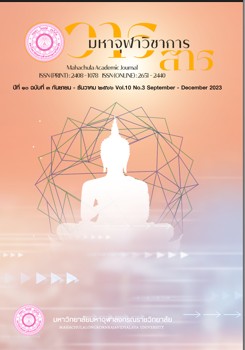An Analytical Study of the Enlightenment of the Foremost Bhikkhunis in Theravada Buddhism: A Case Study of Mahapajapati Gotami, Khema and Uppalavanna
Main Article Content
Abstract
This thesis entitled ‘An analytical study of the enlightenment of the foremost bhikkhunis in Theravada Buddhism; A case study of Mahapajapati Gotami, Khema and Upalavanna has three objectives: (1) to study the enlightenment in Theravada Buddhist scriptures, (2) to study the history and background of these three bhikkhunis, and (3) to analyze the enlightenment of these three bhikkhunis. This research employed the documentary research methodology done by selecting three out of thirteen bhikkhunis who were the foremost female disciples of the Buddha.
The results of the research revealed that the enlightenment of three bhikkhunis were different in terms of the characteristics, events and places. For instance, Mahapajapati Gotami listened to the teaching of the Buddha and then put it into practice and thereby shortly attaining the enlightenment. Khema met the Buddha and saw a vision of a young beautiful woman who was created by the power of Buddha resulting in seeing the possibilities of the unlimitedness of beauty through the physical form and thereby bringing her to the enlightenment in the standing position. After ordination, Upalavanna saw a fire in the barn while working, then entering into the absorption of fire whereby she changed into the insight meditation resulting in bringing her Arahanta immediately. However, all bhikkhunis attained enlightenment with the same virtues consisting of eight kinds of supernormal knowledge, four kinds of the discrimination, eight kinds of emancipation, and six kinds of super knowledge. The body of knowledge gained from the enlightenment and practice leading to the attainment of Dhamma including their biographies of three bhikkhunis who gained the praise from the Buddha as the top female disciples could be somehow regarded as the most valuable inheritance of the Dhamma. Furthermore, it could be also held as the highest benefit to people who properly follow Dhamma in order to obtain the emancipation from suffering. It could be claimed that four assemblies of the Buddha possess the duty in taking care of knowledge of pure Dhamma where the next generation could be given the right path in order to sustain Buddhism as long as possible.
Article Details

This work is licensed under a Creative Commons Attribution-NonCommercial-NoDerivatives 4.0 International License.
References
จําเนียร ทรงฤกษ์. ชีวประวัติพุทธสาวิกา (พระภิกษุณี หรือพระเถรี). พิมพ์ครั้งที่ ๔. กรุงเทพมหานคร: มูลนิธิพ่อนวล แม่พัว ทรงฤกษ์, ๒๕๕๓.
พระปลัดเดโชว์ สุคนฺโธ (ไทยมานิตย์). “ศึกษาการบำเพ็ญบารมีและการบรรลุธรรมของพระปฏาจาราเถรี”. วิทยานิพนธ์พุทธศาสตรมหาบัณฑิต. บัณฑิตวิทยาลัย: มหาวิทยาลัยมหาจุฬาลงกรณราชวิทยาลัย, ๒๕๕๘.
พระพรหมคุณาภรณ์ (ป. อ. ปยุตโต). พจนานุกรมพุทธศาสน์ ฉบับประมวลศัพท์. พิมพ์ครั้งที่ ๒๘. กรุงเทพมหานคร: สำนักพิมพ์ผลิธัมม์, ๒๕๕๙.
พระมหาสังเวย ธมฺมเนตฺติโก (เนตรนิมิต). “การศึกษาเชิงวิเคราะห์เรื่องชีวิตภิกษุณีกับการบรรลุอรหัตผล : เฉพาะที่ปรากฏในเถรีคาถา. วิทยานิพนธ์พุทธศาสตรมหาบัณฑิต. บัณฑิตวิทยาลัย: มหาวิทยาลัยมหาจุฬาลงกรณราชวิทยาลัย, ๒๕๓๖.
พระมหาอำนวย อานนฺโท (จันทร์เปล่ง). “การศึกษาเรื่องการบรรลุธรรมในพระพุทธศาสนาเถรวาท”. วิทยานิพนธ์พุทธศาสตรมหาบัณฑิต. บัณฑิตวิทยาลัย: มหาวิทยาลัยมหาจุฬาลงกรณราชวิทยาลัย, ๒๕๔๒.
พระวรมน ขนฺติโก (วัตถุมา). “ศึกษาสัมมัปปธาน ๔ อันเป็นองค์แห่งการบรรลุธรรม”. วิทยานิพนธ์พุทธศาสตรมหาบัณฑิต. บัณฑิตวิทยาลัย: มหาวิทยาลัยมหาจุฬาลงกรณราชวิทยาลัย, ๒๕๕๔.
มหาจุฬาลงกรณราชวิทยาลัย. พระไตรปิฎกภาษาไทย ฉบับมหาจุฬาลงกรณราชวิทยาลัย. กรุงเทพมหานคร: โรงพิมพ์มหาจุฬาลงกรณราชวิทยาลัย, ๒๕๓๙.
_________. อรรถกถาภาษาไทย พระสุตตันตปิฏก ขุททกนิกาย เถรีคาถา. กรุงเทพมหานคร: โรงพิมพ์มหาจุฬาลงกรณราชวิทยาลัย, ๒๕๕๖.
แม่ชีกฤษณา รักษาโฉม. “การศึกษาเชิงวิเคราะห์บทบาทของพระวินัยธรในพระวินัยปิฏก: ศึกษาเฉพาะกรณี พระอุบาลีเถระ และพระปฏาจาราเถรี”. วิทยานิพนธ์พุทธศาสตรมหาบัณฑิต. บัณฑิตวิทยาลัย: มหาวิทยาลัยมหาจุฬาลงกรณราชวิทยาลัย, ๒๕๔๕.
_________. “การศึกษาปัญหาเรื่องการเสื่อมสูญของภิกษุณีสงฆ์ในพระพุทธศาสนาเถรวาท”. วิทยานิพนธ์พุทธศาสตรดุษฎีบัณฑิต. บัณฑิตวิทยาลัย: มหาวิทยาลัยมหาจุฬาลงกรณราชวิทยาลัย, ๒๕๕๑.
Kenneth A. Locke. Images of the Female Body in the Theragatha and the Therigatha. Hsi Lai Journal of Humanistic Buddhism. Vol.5 (2004) : 256.


